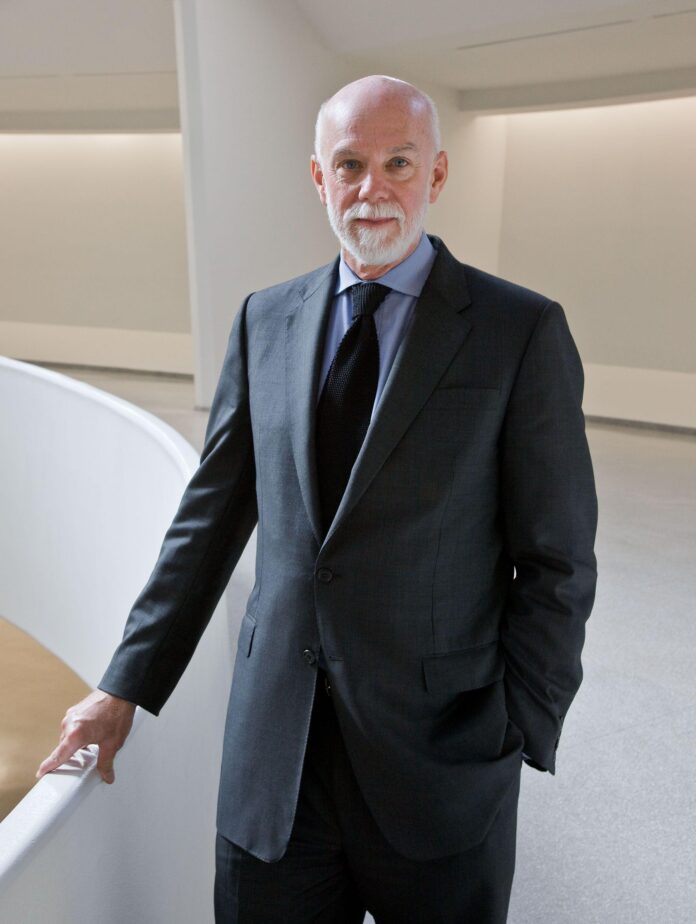Richard Armstrong, the longtime director of the Solomon R. Guggenheim Foundation—which encompasses the eponymous museums in New York, Venice, Bilbao and Abu Dhabi—will be stepping down in 2023 after more than 14 in the role.
Armstrong told the Financial Times in an interview published on 8 July that he will be leaving the Guggenheim “sometime next spring”. “It’ll be almost 15 years by then and that’s a long time,” Armstrong said in the interview. “The board is rejuvenated, and active—it’s a good moment”.
Armstrong inherited an institution undergoing growing pains when his tenure began in 2008, two years after plans for the Guggenheim Abu Dhabi were announced. Like the Bilbao location, Guggenheim Abu Dhabi was to be designed by Frank Gehry, but the construction process on the Emerati museum was perpetually delayed, and while it was initially expected to open in 2012, then 2017, it is now slated for a 2025 opening. At 320,000 square feet, it will be the largest Guggenheim museum.
For a period of time, there were demonstrations across the Guggenheim’s US and European locations protesting the Abu Dabhi construction site’s labour conditions. The protests were led by the Gulf Labor artist coalition, but talks between the Guggenheim and the coalition were suspended in 2016. The Guggenheim also had plans to expand into Helsinki, first announced in 2011, but these plans were dashed in 2016 when the Finnish government cut funding and rejected the institution’s site plans.
Recent years have seen a major shift in the dialogue around museum funding as well as workplace equity, and the Guggenheim was no exception. Under Armstrong, the Guggenheim was the first New York institution to denounce members of the Sackler family in response to their key role in the opioid epidemic. In no longer accepting gifts from the billionaire family and by removing their name from its galleries, the Guggenheim set a standard which was quickly adopted by the Metropolitan Museum and other institutions.
After a 2019 vote, employees of the Guggenheim Museum in New York unionise and, in 2021, reached their first contract agreement with terms that included annual wage increases, scheduling transparency, healthcare programs for full-time workers and more. In a similar vein, as dialogues around workplace inequity among museum workers became more widespread, there was also controversy when it came to light that Armstrong received a pay increase of over $400,000 between 2019 and 2020, while the museum was simultaneously making pandemic-related layoffs and pledging to cut salaries for its top executives.“Richard’s unfailing dedication to the artistic integrity of the Guggenheim constellation and
steadfast commitment to its staff—particularly through the challenges of the past two years—have made the museum stronger and more vibrant,” Wendy Fisher, president of the Guggenheim’s board, said in a statement.
A number of sweeping successes also occurred under Armstrong’s watch. The 2018 to 2019 show of paintings by the turn-of-the-century Swedish artist and mystic Hilma Af Klint—the first major US show devoted to the artist—was the museum’s most viewed exhibition of all time, with over 600,000 visitors coming to see it. The museum also reported that it saw a 34% increase in membership while Af Klint’s show was up, and that over 30,000 copies of the exhibition catalogue were sold.
In efforts to make the museum more international, Armstrong also oversaw the launch of the Guggenheim UBS MAP Global Art Initiative, an effort that ran from 2012 to 2018 in which cultural figures from across South and Southeast Asia, Latin America and the Middle East and North Africa were consulted in efforts to build a more expansive collection.
“I’ll stay involved with art,” Armstrong told the FT in regards to his personal plans for the future. “I don’t have any other vocabulary. And maybe remember a few things and write them down, I don’t know.”

























